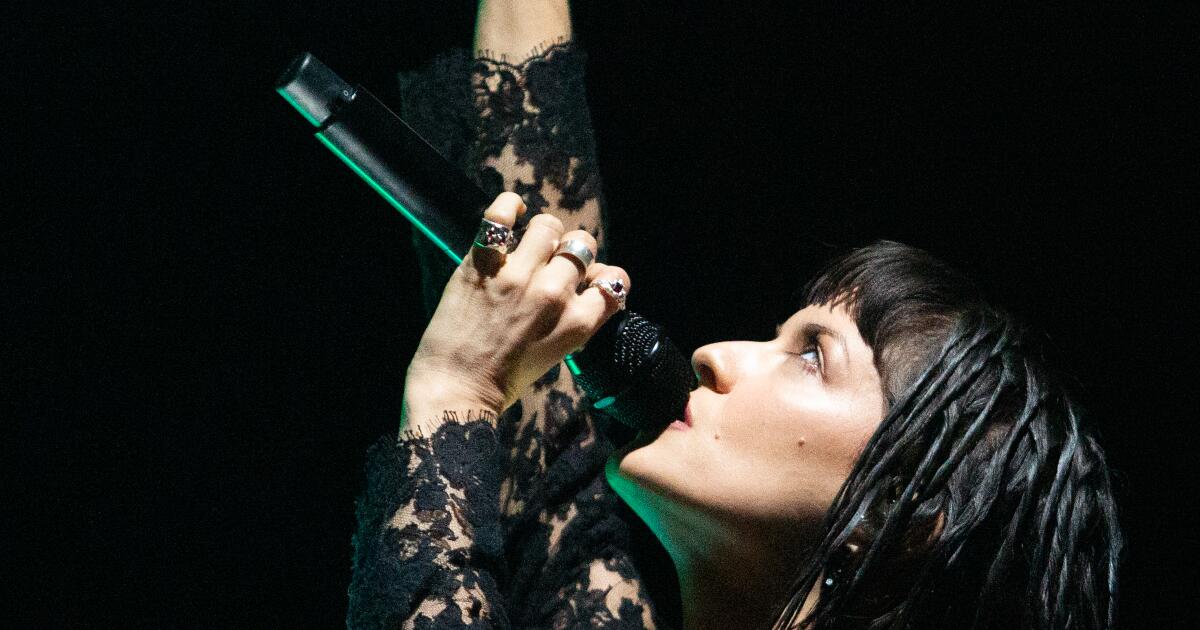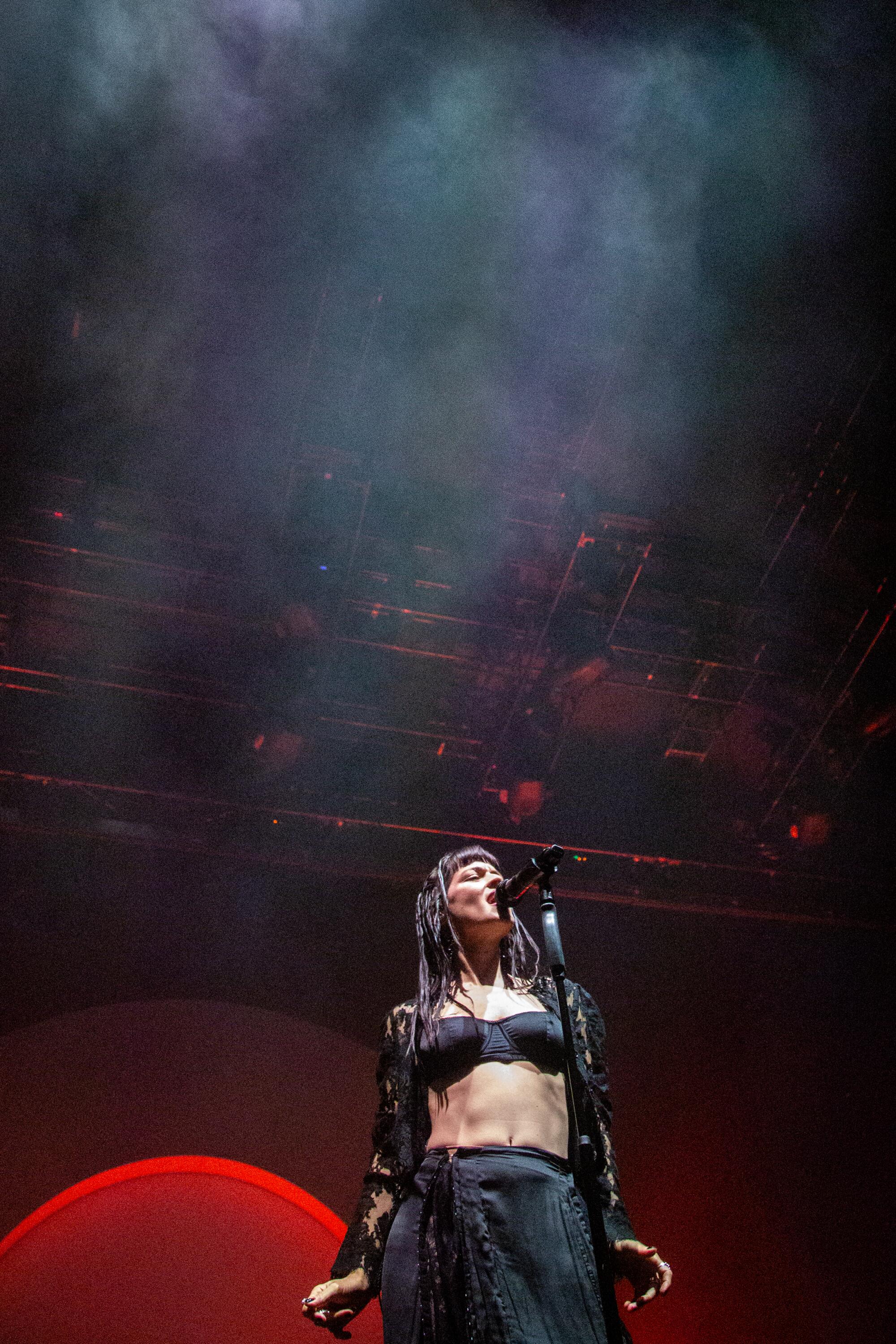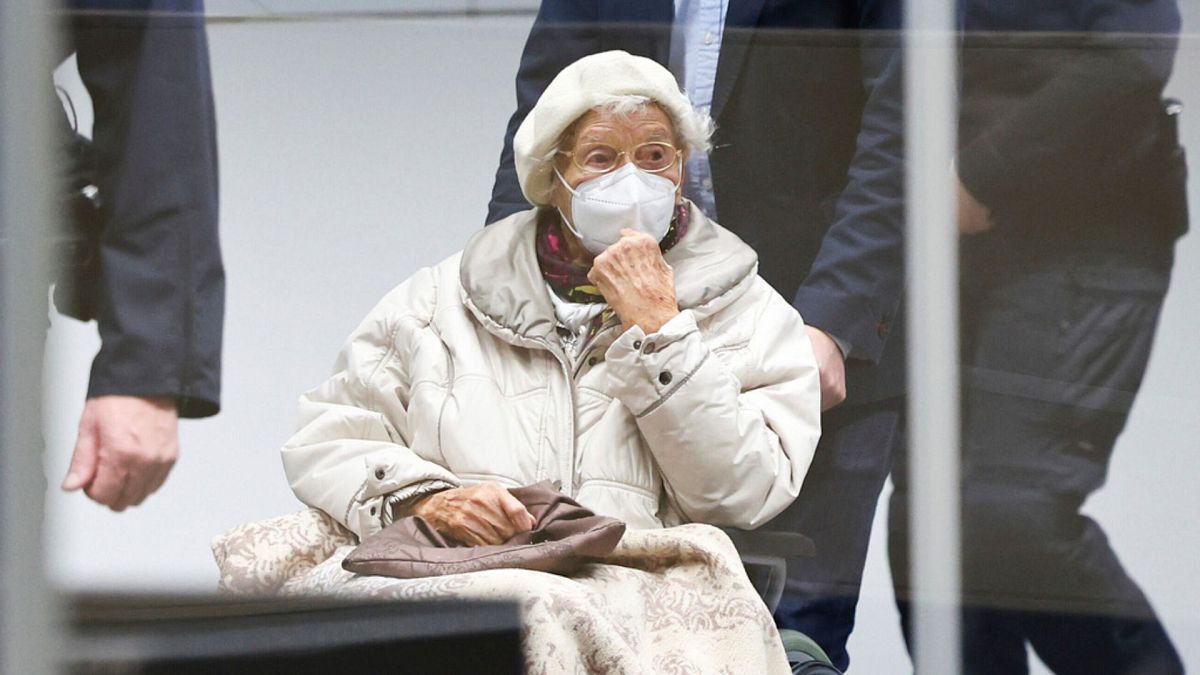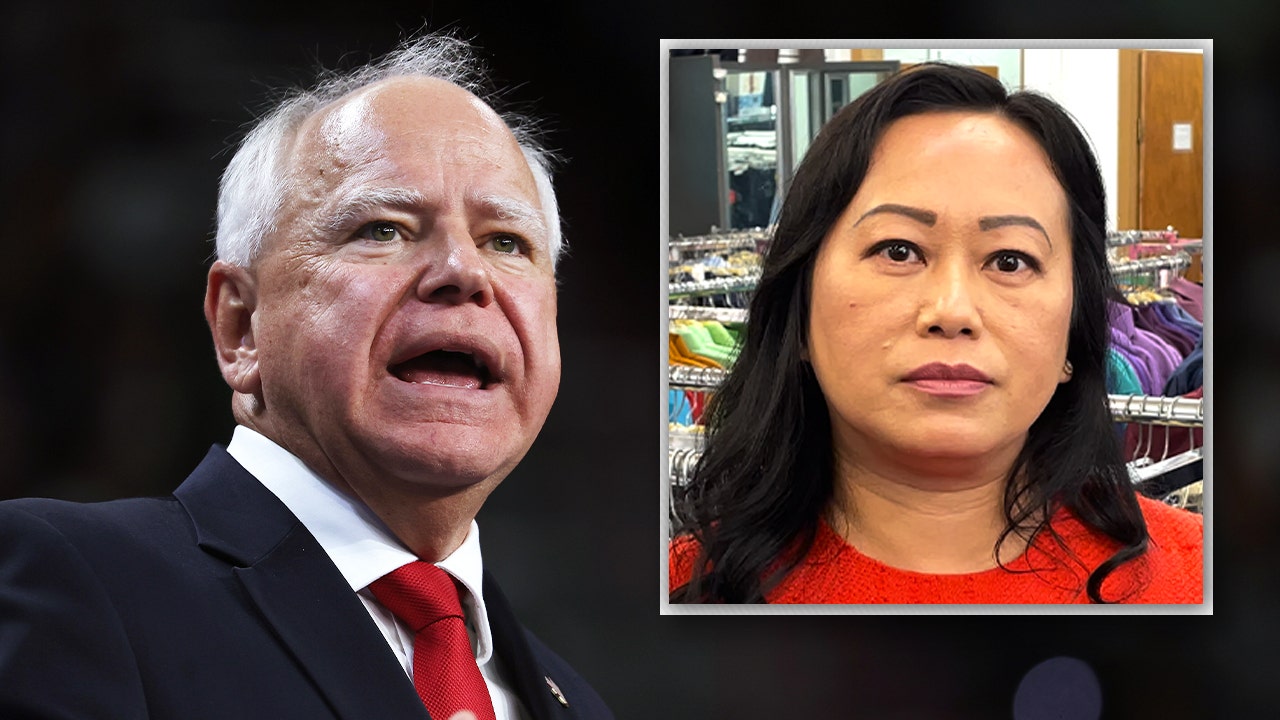Entertainment
María Zardoya, of the Marías, chooses to relive her breakup every night

The chanting crowd’s “otra” wanes as a singular spotlight illuminates María Zardoya. The Marías’ frontwoman lies in a translucent bathtub, microphone in hand and partially submerged in its warm water. The somber piano of “If Only,” a ballad off their sophomore album, “Submarine,” fills the entire Hollywood Forever Cemetery. Zardoya’s voice takes on a melancholic, siren-like quality, while a trumpet adds a noir jazz accent to the eerie display.
As the song’s final notes linger, the 29-year-old singer retreats into the portable body of water, sinking her head well below its surface. Muffling out her surroundings, she says she’s taken back to the exact moments of heartbreak that inspired the L.A.-based band’s latest project, “Submarine,” released in May. The record is an unambiguous look into the romantic breakup between the group’s founders, singer and lyricist Zardoya and Josh Conway, drummer and producer.
Prior to creating the aquatic ethos of “Submarine,” the band was uncertain if they could make it past such a drastic change in dynamics. But with a dedication to vulnerability and their craft, the foursome — Zardoya, Conway, guitarist Jesse Perlman and keyboardist Edward James — were able to overcome this shift and create one of the summer’s most notorious breakup albums.
The Marías, formed in 2016, found their niche in alternative music early in their career. The experimental indie track “Only in My Dreams” and the bilingual, requited love anthem “Cariño” cemented their reputation as up-and-comers.
(Ringo Chiu / For De Los)
Ahead of the Submarine tour’s second L.A. show, I met the Puerto Rican-born singer backstage, in a shaded tent. Small in stature, she wears a floor-length dress with a large floral detail at its center. As she drinks out of an official Marías water bottle that reads “María’s Bathwater” — a layered joke shared between the group and their fan base — she recalls the exact moment she felt the group had passed the breakup test. It was during their show at New York’s Radio City Music Hall, a few weeks prior. The stage setup allowed the singer to go up onto a platform, where she could perform from a new vantage point.
“I had never seen that perspective of the stage before because I’m usually on it. I could see the guys below and I got super emotional and started crying a little bit. I was like, ‘Boys, like, we did it,’” said Zardoya. “It was such a beautiful moment because we overcame so much together and it feels like a family now. We’re stronger than ever.”
But this unified feeling among the band didn’t happen overnight.
The Marías, formed in 2016, found their niche in alternative music early in their career. The experimental indie track “Only in My Dreams” and the bilingual, requited love anthem “Cariño” cemented their reputation as up-and-comers. Ever since the beginning, the group has relied on a certain kind of duality to set them apart. As Zardoya pens her lyrics in both English and Spanish, Conway was quick to incorporate Latin influences to create a more accurate representation of who they are sonically — putting a unique spin on what could’ve been cookie-cutter indie music.
“I introduced him to so much Latin music. From just being around my family, the music and the culture, he picked up on things pretty quickly,” Zardoya said. “He knew that it was important for me to showcase this part of who I am. So when he started making this mix of reggaeton and indie psychedelic, things got really interesting.”
They continued to carve their path in the alternative space with their Grammy-nominated debut album, “Cinema,” in 2021. Their mesmerizing infusion of soulful rock, dreamy pop and Latin rhythms has stayed consistent, yet still inventive over the band’s nine years together. They have even collaborated with fellow Latin musicians Bad Bunny, Young Miko and Tainy.

The sold-out crowd at Hollywood Forever Cemetery last week sings along with the Marías.
(Ringo Chiu / For De Los)
“We’ve been listening to the Marías since we were young kids in junior high, and integrating Spanish into their genre means a lot to us,” said Andres Garcia, a longtime fan who attended the L.A. show. “I love how the Marías have still been able to stick to the indie genre while still being who they are. It’s something that I notice a lot of Latino indie artists are doing now.”
During the Hollywood performance, Zardoya called out for her “Latino family” and started to list various Latin American countries to see who was represented. The lead singer says she is thankful to share the “experience of being Latin in the U.S.” with her fans. Each night on the Submarine tour, Zardoya makes a point to walk through the crowd while singing. As people push and shove to get a glimpse of the lace-cladden vocalist, she is reminded that performing “makes all the moments of heartbreak [behind ‘Submarine’] worth it.”
“Submarine” is deeply rooted in the idea of tragic love. No matter how upbeat or funky, the tracks may sound — all its lyrics come back to a life-altering heartbreak. “Love You Anyway,” a psychedelic rock-infused track, is centered around the lyrics, “I know that you’ve always been in love with me / But I know that you’ve also had to watch me leave” — directly referencing that the two will always be in love, but have to accept not being together. The dreamy yet heart-wrenching “Sienna” transports listeners to another timeline where things work out between Zardoya and Conway, and they have a child named Sienna who “would’ve been cute” and “would look just like you.”
Zardoya says writing the album was one of the most humbling experiences. After the seven-year relationship, she says she was forced to look at life differently. During those challenging moments of growth, she turned to Buddhism.
“What’s changed the most with me is the beauty of embracing the present moment. Nothing lasts forever. The only thing that exists is right here, right now,” Zardoya says. “That’s helped me, even on tour, in the sense of just taking it one thing at a time and not seeing the big picture.”

María Zardoya takes center stage at the Marías’ second L.A. performance.
(Ringo Chiu / For De Los)
After focusing so much emotional labor into “Submarine,” Zardoya was under the impression that sharing it with the world might help her move on. But after performing its personal contents on tour, she finds herself “reliving a trauma” night after night.
“It kind of depends on the night. Some nights I’m like, f— this. I’m tired of dreaming about this. I’m tired of thinking about this. I don’t wanna keep reliving this drama,” Zardoya said. “Then other times I’m like, ‘Thank God I went through it.’ It humbled me as a person. It made me more thankful for life and more tolerant of difficult experiences.”
Walking a fine line between emotional exhaustion and being gracious, she’s accepted that the aftermath of her breakup will be longer than the typical person who isn’t in a band with their ex-boyfriend. As she retells the highs and lows of the relationship through the nightly set list, she’s faced with a decision.
“I want to emit the emotion of these songs. And in order to get there, I have to reexperience what the song is about. It’s a choice,” says Zardoya. “I could choose to just sing the song and work on moving on from the situation. But I want to feel everything and I want the fans to feel it. Because what’s the point if you’re not?”
With only a few more stops in the U.S., the Marías will take the Submarine tour to Europe in late October. But the band still has plans for “Submarine,” Zardoya reveals that they will release a follow-up EP to the album. Some of the EP’s songs were written alongside the album while others were written after its release, but still belong to the same world.
“I’d say you’re still feeling like you’re underwater, but even more solitude,” says Zardoya. “There’s no bangers. They’re all, like, ‘crying in the club’ songs.”
As the last notes of “Cariño,” the final song in their set, ring out, Zardoya makes a dash toward the end of the stage. She jumps headfirst into the sea of overjoyed fans, with the intention of crowd surfing. The front section of the venue raises their hands high, in preparation to catch the singer. As the rest of the band continues to play, she is passed through the condensed audience — with a smile that can be seen from the crowd’s edges. Instead of the typical breakup comforts, like watching cheesy rom-coms or having a girl’s night out, Zardoya finds her greatest comfort in the hands of her listeners.

Movie Reviews
'Maria' Reviews: What Critics Are Saying About Angelina Jolie's Transformation and Singing as the Opera Diva
:max_bytes(150000):strip_icc():focal(722x354:724x356)/Angelina-jolie-becomes-maria-callas-100923-01-2cce48d3de044c459234fd2c2ef1e0d7.jpg)
Early reactions to Angelina Jolie’s latest movie are signaling the superstar’s triumphant return to the big screen.
Maria, director Pablo Larraín’s new biopic about opera singer Maria Callas, premiered at the Venice International Film Festival on Thursday, Aug. 29.
Deadline film critic Stephanie Bunbury described Jolie, 49, as “an almost magical match for the real diva,” in a review of the film.
“The actor’s commitment to this creation is obvious at every turn,” she wrote. “Knowing that Callas was only happy when on stage, she learned to sing for the role; the voice we hear is a blend of Callas and Jolie’s own. Even more importantly, we can see her chest rise and veins swell as she is consumed, body and soul, by the physical and emotional effort of singing.”
The Independent’s Clarisse Loughrey praised Jolie’s performance in a review: “It’s a career-defining bit of synchronicity, bolstered by one of Jolie’s very best performances. Her work has always been about that immaculate sense of control over posture and tone.”
Pablo Larrain
Never miss a story — sign up for PEOPLE’s free daily newsletter to stay up-to-date on the best of what PEOPLE has to offer, from celebrity news to compelling human interest stories.
Variety‘s Owen Gleiberman wrote that Jolie “seizes our attention, playing Maria as woman of wiles who is imperious, mysterious, fusing the life force of a genius diva with the downbeat emotional fire of a femme fatale,” in the movie, while expressing some issues with the film as a whole.
“Jolie, for the first time in years, reminds you that she can be a deadly serious actor of commanding subtlety and power,” Gleiberman added.
Writing for the film and television website Little White Lies, Hannah Strong asserted that Jolie has “found the role of a lifetime” in a similar manner to Natalie Portman’s portrayal of Jackie Kennedy in Larraín’s 2016 film Jackie.
“It’s quite something to watch a woman as instantly recognizable as Jolie be so bewitching while playing someone else incredibly famous (always a challenge in biopics where footage of the subject exists) and without the layers of prosthetics that actors normally rely on to ‘transform,’ ” she wrote. “Yet Jolie achieves such with a refined purr of a European accent and something equally feile in her gait.”
Fionnuala Halligan wrote for Screen Daily that the movie exceeds with “a sense of elusiveness and the unexpected even within its familiar structure,” adding, “Larrain leans into Jolie’s aimlessness as she wanders around Paris by creating scenes and memories that take place only in her mind, and adding orchestras which spring to life across the city to usher in ’Madame Butterfly’, for example, in the rain.”
Pablo LarraÃn
Maria, written by Steven Knight, is the latest in a string of biographical films from director Larraín, 48. His previous Spencer and Jackie featured Oscar-nominated performances from Kristen Stewart as Princess Diana and Portman as the former first lady, respectively.
“I take very seriously the responsibility to Maria’s life and legacy. I will give all I can to meet the challenge,” Jolie said in a statement when the project was announced in 2022. Callas, who became an international sensation thanks to her three-octave vocal range, died in Paris in 1977 of a heart attack, according to The Guardian.
Maria, also set to screen at the Telluride Film Festival this weekend, does not yet have a release date; Netflix purchased the film’s distribution rights.
Movie Reviews
‘Maria’ Review: Angelina Jolie’s Maria Callas Suffers at a Chilly Distance in Pablo Larraín’s Biopic

In Jackie and Spencer, Pablo Larraín removed any trace of starch from the historical bio-drama to examine, with penetrating intimacy, famous women in moments of extreme emotional distress played out in the glare of a global spotlight. Intimacy is the key factor lacking in the third part of the gifted Chilean director’s unofficial trilogy, Maria. Starring Angelina Jolie as revered operatic soprano Maria Callas over the final week of her life in Paris, the movie is like a glittering jewel in a glass showcase, inviting you to look but not touch.
That doesn’t mean it’s uninvolving or that Jolie’s technically precise interpretation isn’t impressive. But there’s a meta collision between a star whose celebrity has long eclipsed her acting achievements, making it all but impossible for her to disappear into a character, and a subject who constructed an imperious persona for herself, performing even when she wasn’t on a stage.
Maria
The Bottom Line Sings but misses the high notes.
Venue: Venice Film Festival (Competition)
Cast: Angelina Jolie, Pierfrancesco Favino, Alba Rohrwacher, Valeria Golino, Haluk Bilginer, Stephen Ashfield, Valeria Golino, Kodi Smit-McPhee, Vincent Macaigne, Lydia Koniordou, Aggelina Papadopoulou
Director: Pablo Larraín
Screenwriter: Steven Knight
2 hours 3 minutes
Doubling down on icons brings a lot of weight for a role to bear. It results less in a kinship between actor and character than a twofold remove — an exercise in character study, a tad glacial and distancing, rather than a flesh-and-blood portrait.
The movie is beautifully crafted, of course, graced with sumptuous visuals from the great Ed Lachman. The cinematographer captures the City of Light in 1977 in soft autumnal shades highly evocative of the period and shifts into black-and-white or grainy color stock for Callas’ many retreats into memory. Lachman, who was Oscar-nominated for his breathtaking chiaroscuro work on Larraín’s last feature, El Conde, shot Maria using a textured mix of 35mm, 16mm and Super 8mm, along with vintage lenses.
The DP’s outstanding work enhances the refined contributions of production designer Guy Hendrix Dyas and costume designer Massimo Cantini Parrini. The latter’s stunning gowns include chic ensembles worn at public occasions and exquisite costumes for Callas’ famed stage roles, some of which the singer is seen burning as she separates herself from the past.
“I’m in the mood for adulation,” Callas tells a Paris waiter when he suggests she might be more comfortable inside than at an outdoor café table. “I come to restaurants to be adored.”
Larraín and screenwriter Steven Knight, who previously penned Spencer, comply to a degree. Their film is an act of mournful worship for a diva who seems almost too arch, too cloaked in affectation to read as a vulnerable human being — even as her body is shutting down and she’s racked with insecurities about her voice while planning to sing again, more than four years after she last performed. Often, it feels like the filmmakers are scrutinizing Callas with the disorienting effect of a magnifying glass.
The balance doesn’t seem quite right when you feel more for the loyal household staff who love and protect her than you do for the woman lying dead on the carpet by the grand piano. That image opens the movie, preceded only by a slow pan around Callas’ stately apartment.
Knight employs the pedestrian framing device of an interview, with a TV arts reporter and cameraman coming to Maria’s home. The journalist’s name, Mandrax (Kodi Smit-McPhee in a thankless role), is a tipoff that he’s a product of Maria’s mind given that it’s also the name of the medication on which she’s most dependent — more commonly sold as Quaaludes in the U.S.
In what seems a ritual maintained for some time, Maria’s hyper-vigilant butler, Ferruccio (Pierfrancesco Favino), removes the pills from her dressing table and later from the handbags and coat pockets where she has stashed handfuls of them around the room. She has also stopped eating for days at a time, feeding meals prepared by her housekeeper Bruna (Alba Rohrwacher) to her poodles.
She becomes peevish about the dire warnings of her medic, Dr. Fointainebleau (Vincent Macaigne), that her heart and liver are completely shot and that the stress of attempting to perform plus the meds she would need to get through it risk killing her.
The dominant thread becomes not that grim final week, punctuated by abortive rehearsals with a gently coaxing accompanist (Stephen Ashfield), but the singer’s mental forays into her past, from her unhappy childhood with an exploitative mother (Lydia Koniordou) through her love affair with Aristotle Onassis (Haluk Bilginer), whose aggressive charms instantly shoved her husband to the sidelines. Since the Greek shipping magnate eventually left her for Jackie Kennedy, there’s a satisfying full-circle completion with the subject of Larraín’s first film in the trilogy. But don’t expect a cameo from Jackie star Natalie Portman.
Maria’s memories are additionally crowded with her triumphs in the world’s most prestigious opera houses — Covent Garden, The Met, La Scala — flooding the movie with glorious music. The naked emotionality and piercing tragedy of the immortal operatic heroines is a poignant fit for Callas’ end-of-life story and a useful counterpoint to her studied poise and aloofness in this interpretation. The power of work by Verdi, Puccini, Bellini, Donizetti, Catalani and Cherubini goes a long way toward delivering the pathos that often seems muted by Larraín’s approach.
Passages from some of the most celebrated classical operas effectively supplant the role of a score. The soul-stirring choice of musical bookends for the film starts with Desdemona’s supplicant prayer, “Ave Maria,” from Otello, and closes with “Vissi d’Arte” from Tosca, in which a woman who lived for art and love feels abandoned by God. Opera enthusiasts will find much here to savor when the movie drops on Netflix at a date to be determined.
Commendably, Jolie undertook more than six months of rigorous vocal training for the part, also working on breathing and posture alongside specifics like accent. The singing we hear in Maria is a synthesized mix of star and subject. Arias from her prime are predominantly Callas recordings, but her voice in the 1977 scenes, older and rustier after years of vocal strain and a long absence from the stage, blends in a significant amount of Jolie. Neither lip-syncing nor karaoke, it’s a more intricate hybrid.
A number of striking moments use music to show memory and fantasy bleeding into Callas’ diminishing hold on reality. For instance, Maria strolling through the city with the Eiffel Tower in the background, in her mind marshaling a crowd of everyday Parisians singing the “Anvil Chorus” from Il Trovatore; or a full orchestra on the steps of one of the French capital’s grand historic buildings, playing in the rain while a throng of costumed geishas perform the “Humming Chorus” from Madama Butterfly. That ineffably moving passage of music, representing Butterfly’s calm vigil as she waits for Pinkerton’s return, adds emotional heft to the tragedy looming in Maria’s life.
Conflict surfaces when a music reporter for Le Figaro pulls a dirty trick and then confronts Maria outside the rehearsal auditorium with the view that her voice is irreparably ragged. But Knight’s script doesn’t capitalize on this as a moment of self-reckoning, instead limiting the scene to a distressing invasion of privacy.
The movie aims to depict a celebrated woman, whose life has been as much about sacrifice as reward, seeking to take control, to look back and see the truth as death approaches. But its moments of illumination are hazy. There’s little that comes close to the compassion and insight Larraín brought to his portraits of Jackie Kennedy and Princess Diana, even though it’s very much of a piece with those movies.
The tenderness of a scene in which Maria’s sister (Valeria Golino) urges her to put her troubled childhood behind her (“Close the door, little sister”) inadvertently points up how few opportunities we are given to get on comparably intimate terms with the protagonist.
In fact, the most heartbreaking moment for me came at the end, when the film returns to the day of Callas’ death from a heart attack, aged just 53. A high-pitched shriek that at first sounds like some strangled note from an aria is revealed to have come from one of her poodles, the dog’s cry of anguish becoming a loud expression of the hushed sorrow shown by Ferruccio and Bruna (Favino and Rohrwacher are both wonderful) as they reach for each other’s hand for comfort.
Still, Maria is a far more daring and unconventional take on the final chapter of the legendary soprano’s life than Franco Zeffirelli’s boilerplate 2002 biopic, Callas Forever, starring Fanny Ardant. And Larraín’s film becomes retroactively more affecting when the lovely archival images of Callas over the end credits, full of vitality at the peak of her career, widen the perspective on her sad, accelerated decline.
Entertainment
Next year's Oscars have a surprising original song contender: Kristen Wiig

“‘Talented musician’ might be a little strong” to describe Kristen Wiig, the “Saturday Night Live” veteran demurs when complimented about her chops. So another label will have to do.
How about “Oscar-nominated musician Kristen Wiig”?
It’s now a distinct possibility: Netflix will campaign for Wiig and co-writer Sean Douglas in the original song category for the folksy comic ditty “Harper and Will Go West,” from the forthcoming documentary “Will & Harper,” the company confirmed exclusively to The Times. The film, which premiered at this year’s Sundance Film Festival, arrives on Netflix on Sept. 27 after an Oscar-qualifying theatrical run.
“Will & Harper” follows former “SNL” star Will Ferrell and his friend, longtime “SNL” writer Harper Steele, on a cross-country road trip after Steele comes out as a trans woman. Along the way, they meet trans people carving out a life in small-town America, discuss the challenges Steele faced pre- and post-transition and much more. They also park their classic Jeep Wagoneer to conscript Wiig, via FaceTime, to write a “tear-to-your-eye, fun, uptempo, jazzy with a little country” theme song for their journey.
The resulting number, filmed in Wiig’s backyard and accompanied by ukulele and saxophone, combines humor — the opening verse rhymes the song’s title with the phrase “a couple brand new breasts” — and heartfelt emotion (“A friend is a friend is a friend … ’til the end”) in a way that reflects the film as a whole.
“It was kind of like this funny thing when they called me saying they wanted it to be all these different types of music,” laughs Wiig, who studied piano and sang in church and school choirs as a child, before taking up the ukulele in recent years. But instead of a full-on spoof, she, Douglas and the film’s director, Josh Greenbaum, decided to “steer away from something too jokey”: “We just wanted a nice song for the two of them.”
Songs with humorous elements have previously broken into the Oscars’ original song category. The film academy famously nominated the satirical, profanity-laden “Blame Canada” from “South Park: Bigger, Longer & Uncut” in 2000 and has more recently tapped the likes of “Husavik,” from the 2020 comedy “Eurovision Song Contest: The Story of Fire Saga,” and “I’m Just Ken,” from last year’s blockbuster “Barbie.” The most recent winner, also from “Barbie,” was “What Was I Made For?” by Billie Eilish and Finneas O’Connell.
-

 Connecticut6 days ago
Connecticut6 days agoOxford church provides sanctuary during Sunday's damaging storm
-

 Technology1 week ago
Technology1 week agoBreakthrough robo-glove gives you superhuman grip
-

 News1 week ago
News1 week agoEx-officer convicted in George Floyd's killing is moved to new prison
-

 News1 week ago
News1 week agoVideo: Biden Delivers Keynote on First Night of D.N.C.
-

 News1 week ago
News1 week agoVideo: D.N.C. Holds Enthusiastic Roll Call to Nominate Harris
-

 World1 week ago
World1 week agoGerman court upholds conviction of former Nazi camp secretary, aged 99
-

 Politics1 week ago
Politics1 week agoFormer teacher reveals which students suffered 'the most' under Walz's pandemic-era guidelines
-

 World1 week ago
World1 week agoPanama deports 29 Colombian migrants from Darien Gap under US deal












